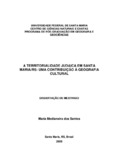| dc.creator | Santos, Maria Medianeira dos | |
| dc.date.accessioned | 2009-10-06 | |
| dc.date.available | 2009-10-06 | |
| dc.date.issued | 2009-08-10 | |
| dc.identifier.citation | SANTOS, Maria Medianeira dos. JEWISH TERRITORIALITY IN SANTA MARIA/RS: A CONTRIBUTION TO THE CULTURAL GEOGRAPHY. 2009. 170 f. Dissertação (Mestrado em Geociências) - Universidade Federal de Santa Maria, Santa Maria, 2009. | por |
| dc.identifier.uri | http://repositorio.ufsm.br/handle/1/9299 | |
| dc.description.abstract | The process of construction of the State's territory, as well as of its cultural identity is related to the influence that the several migration flows had in elapsing of time, in the southern space of RS. It is emphasized that this work focuses the Jewish cultural group. This ethnic group penetrated, in 1904, in the territory of the Municipal district of Santa Maria/RS, and they were the responsible for the formation of the Philippson's Colony. As specific objective the research sought: (a) to analyze the responsible conditions for the (de- and re-) territorialization of the Jewish cultural group, in Santa Maria's territory, in the beginning of the 20th century; (b) to verify the aspects of the re-territorialization which provided the formation of the Philippson's Colony/Santa Maria, for the Jews in the State; and (c) to identify the process and the dynamics of the territorial development of Philippson, as well as the space dispersion
of the Jews in the urban environment. Methodologically, it was taken a theoretical referential as start point, turned to the thematic in evidence and, in a second moment, field work took place. As to territorial development of Philippson, it can be said that, initially, the rural space was destined for the Jews. However, the territorial
dynamics performed by them, culminated with the abandonment of the agricultural activities and in their turn to the urban environment of Santa Maria, in which they
were devoted, the great majority, to the commercial area. As to the materialization of the Jewish culture, that can be visualized in Santa Maria's urban landscape through
the Synagogue Yitzhak Rabin, the house of Jacob established on Rio Branco Avenue, the Israeli cemetery, located in the neighborhood Chácara das Flores, and
moreover, the Jewish cemetery in the municipal district of Itaara. | eng |
| dc.description.sponsorship | Coordenação de Aperfeiçoamento de Pessoal de Nível Superior | |
| dc.format | application/pdf | por |
| dc.language | por | por |
| dc.publisher | Universidade Federal de Santa Maria | por |
| dc.rights | Acesso Aberto | por |
| dc.subject | Judeus | por |
| dc.subject | Migração judaica | por |
| dc.subject | Território | por |
| dc.subject | Jews | eng |
| dc.subject | Jewish migration | eng |
| dc.subject | Territory | eng |
| dc.title | A territorialidade judaica em Santa Maria/RS: uma contribuição à geografia cultural | por |
| dc.title.alternative | Jewish territoriality in Santa Maria/RS: a contribution to the cultural geography | eng |
| dc.type | Dissertação | por |
| dc.description.resumo | O processo de construção do território gaúcho, bem como da sua identidade cultural está relacionada à influência que as diversas correntes migratórias desempenharam no decorrer do tempo, no espaço sul-rio-grandense. Enfatiza-se que este trabalho enfoca o grupo cultural judaico. Este grupo étnico adentrou no território pertencente ao Município de Santa Maria/RS em 1904, e foram os responsáveis pela formação
da Colônia Philippson. Como objetivo específico a pesquisa procurou: (a) analisar as condições responsáveis pela (des e re) territorialização do grupo cultural judaico, em território santa-mariense, no início do século XX; (b) verificar os aspectos da reterritorialização, o qual proporcionou a formação da Colônia Philippson/Santa Maria pelos judeus no estado gaúcho e (c) identificar o processo e a dinâmica do
desenvolvimento territorial de Philippson, bem como a dispersão espacial dos judeus no meio urbano. Metodologicamente, partiu-se do referencial teórico, direcionado para a temática em evidência e, em um segundo momento realizou-se o trabalho de campo. Quanto ao desenvolvimento territorial de Philippson, pode-se dizer que,
inicialmente, o espaço rural foi o destinado para os judeus. No entanto, a dinâmica territorial desencadeada pelos mesmos, culminou com o abandono das atividades agrícolas e no seu direcionamento ao meio urbano de Santa Maria, na qual eles
dedicaram-se, na grande maioria, ao ramo comercial. Quanto à materialização da cultura judaica, esta pode ser visualizada na paisagem urbana de Santa Maria através da Sinagoga Yitzhak Rabin, da casa Jacob estabelecida na Avenida Rio
Branco e do cemitério israelita localizado no Bairro Chácara das Flores, além do cemitério judaico no município de Itaara. | por |
| dc.contributor.advisor1 | Bezzi, Meri Lourdes | |
| dc.contributor.advisor1Lattes | http://buscatextual.cnpq.br/buscatextual/visualizacv.do?id=K4787163A1 | por |
| dc.contributor.referee1 | Gil Filho, Sylvio Fausto | |
| dc.contributor.referee1Lattes | http://buscatextual.cnpq.br/buscatextual/visualizacv.do?id=K4797805J2 | por |
| dc.creator.Lattes | http://buscatextual.cnpq.br/buscatextual/visualizacv.do?id=K4168628Z9 | por |
| dc.publisher.country | BR | por |
| dc.publisher.department | Geociências | por |
| dc.publisher.initials | UFSM | por |
| dc.publisher.program | Programa de Pós-Graduação em Geografia e Geociências | por |
| dc.subject.cnpq | CNPQ::CIENCIAS EXATAS E DA TERRA::GEOCIENCIAS | por |


